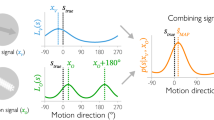Abstract
The optic tectum of the barn owl contains a map of auditory space. We found that, in response to moving sounds, the locations of receptive fields that make up the map shifted toward the approaching sound. The magnitude of the receptive field shifts increased systematically with increasing stimulus velocity and, therefore, was appropriate to compensate for sensory and motor delays inherent to auditory orienting behavior. Thus, the auditory space map is not static, but shifts adaptively and dynamically in response to stimulus motion. We provide a computational model to account for these results. Because the model derives predictive responses from processes that are known to occur commonly in neural networks, we hypothesize that analogous predictive responses will be found to exist widely in the central nervous system. This hypothesis is consistent with perceptions of stimulus motion in humans for many sensory parameters.
This is a preview of subscription content, access via your institution
Access options
Subscribe to this journal
Receive 12 print issues and online access
$209.00 per year
only $17.42 per issue
Buy this article
- Purchase on Springer Link
- Instant access to full article PDF
Prices may be subject to local taxes which are calculated during checkout






Similar content being viewed by others
References
Berry, M.J., II, Brivanlou, I.H., Jordan, T.A. & Meister, M. Anticipation of moving stimuli by the retina. Nature 398, 334–338 (1999).
Ingham, N.J., Hart, H.C. & McAlpine, D. Spatial receptive fields of inferior colliculus neurons to auditory apparent motion in free field. J. Neurophysiol. 85, 23–33 (2001).
Wilson, W.W. & O'Neill, W.E. Auditory motion induces directionally dependent receptive field shifts in inferior colliculus neurons. J. Neurophysiol. 79, 2040–2062 (1998).
Spitzer, M.W. & Semple, M.N. Responses of inferior colliculus neurons to time-varying interaural phase disparity: effects of shifting the locus of virtual motion. J. Neurophysiol. 69, 1245–1263 (1993).
Spitzer, M.W. & Semple, M.N. Transformation of binaural response properties in the ascending auditory pathway: influence of time-varying interaural phase disparity. J. Neurophysiol. 80, 3062–3076 (1998).
McAlpine, D., Jiang, D., Shackleton, T.M. & Palmer, A.R. Responses of neurons in the inferior colliculus to dynamic interaural phase cues: evidence for a mechanism of binaural adaptation. J. Neurophysiol. 83, 1356–1365 (2000).
Malone, B.J., Scott, B.H. & Semple, M.N. Context-dependent adaptive coding of interaural phase disparity in the auditory cortex of awake macaques. J. Neurosci. 22, 4625–4638 (2002).
Wagner, H. Receptive fields of neurons in the owl's auditory brainstem change dynamically. Eur. J. Neurosci. 2, 949–959 (1990).
Knudsen, E.I., Knudsen, P.F. & Masino, T. Parallel pathways mediating both sound localization and gaze control in the forebrain and midbrain of the barn owl. J. Neurosci. 13, 2837–2852 (1993).
Moiseff, A. & Konishi, M. Neuronal and behavioral sensitivity to binaural time differences in the owl. J. Neurosci. 1, 40–48 (1981).
Payne, R.S. Acoustic location of prey by barn owls (Tyto alba). J. Exp. Biol. 54, 535–573 (1971).
Knudsen, E.I. & Konishi, M. Mechanisms of sound localization in the barn owl (Tyto alba). J. Comp. Physiol. 133, 13–21 (1979).
Olsen, J.F., Knudsen, E.I. & Esterly, S.D. Neural maps of interaural time and intensity differences in the optic tectum of the barn owl. J. Neurosci. 9, 2591–2605 (1989).
Keller, C.H., Hartung, K. & Takahashi, T.T. Head-related transfer functions of the barn owl: measurement and neural responses. Hear. Res. 118, 13–34 (1998).
Knudsen, E.I., Esterly, S.D. & du Lac, S. Stretched and upside-down maps of auditory space in the optic tectum of blind-reared owls; acoustic basis and behavioral correlates. J. Neurosci. 11, 1727–1747 (1991).
Brainard, M.S. & Knudsen, E.I. Sensitive periods for visual calibration of the auditory space map in the barn owl optic tectum. J. Neurosci. 18, 3929–3942 (1998).
du Lac, S. & Knudsen, E.I. Neural maps of head movement vector and speed in the optic tectum of the barn owl. J. Neurophysiol. 63, 131–146 (1990).
Cai, H., Carney, L.H. & Colburn, H.S. A model for binaural response properties of inferior colliculus neurons. II. A model with interaural time difference-sensitive excitatory and inhibitory inputs and an adaptation mechanism. J. Acoust. Soc. Am. 103, 494–506 (1998).
Borisyuk, A., Semple, M.N. & Rinzel, J. Adaptation and inhibition underlie responses to time-varying interaural phase cues in a model of inferior colliculus neurons. J. Neurophysiol. 88, 2134–2146 (2002).
Knudsen, E.I. Auditory and visual maps of space in the optic tectum of the owl. J. Neurosci. 2, 1177–1194 (1982).
Konishi, M. Coding of auditory space. Annu. Rev. Neurosci. 26, 31–55 (2003).
Knudsen, E.I., Blasdel, G.G. & Konishi, M. Sound localization by the barn owl (Tyto alba) measured with the search coil technique. J. Comp. Physiol. 133, 1–11 (1979).
Gold, J.I. & Knudsen, E.I. Adaptive adjustment of connectivity in the inferior colliculus revealed by focal pharmacological inactivation. J. Neurophysiol. 85, 1575–1584 (2001).
Gutfreund, Y. & Knudsen, E.I. Adaptation in the auditory space map of the barn owl. J. Neurophysiol. 96, 813–825 (2006).
Knudsen, E.I. & Konishi, M. Center-surround organization of auditory receptive fields in the owl. Science 202, 778–780 (1978).
Perrott, D.R. & Musicant, A.D. Minimum auditory movement angle: binaural localization of moving sound sources. J. Acoust. Soc. Am. 62, 1463–1466 (1977).
Sheth, B.R., Nijhawan, R. & Shimojo, S. Changing objects lead briefly flashed ones. Nat. Neurosci. 3, 489–495 (2000).
Nijhawan, R. Motion extrapolation in catching. Nature 370, 256–257 (1994).
Alais, D. & Burr, D. The “Flash-Lag” effect occurs in audition and cross-modally. Curr. Biol. 13, 59–63 (2003).
DeBello, W.M. & Knudsen, E.I. Multiple sites of adaptive plasticity in the owl's auditory localization pathway. J. Neurosci. 24, 6853–6861 (2004).
Acknowledgements
We thank S. Baccus, R. Aldrich, A. Keuroghlian, D. Winkowski and K. Maczko for helpful comments on this paper, and P. Knudsen for technical assistance. I.B.W. and J.F.B. are recipients of National Science Foundation graduate research fellowships. J.F.B. is a recipient of a National Research Service Award. Support for the experiments came from the US National Institutes of Health.
Author information
Authors and Affiliations
Contributions
E.I.K., J.F.B. and I.B.W. conceived the experiments and wrote the paper. J.F.B. and I.B.W. performed the experiments. J.F.B. performed the data analysis and statistics. I.B.W. developed the computational model.
Corresponding author
Ethics declarations
Competing interests
The authors declare no competing financial interests.
Rights and permissions
About this article
Cite this article
Witten, I., Bergan, J. & Knudsen, E. Dynamic shifts in the owl's auditory space map predict moving sound location. Nat Neurosci 9, 1439–1445 (2006). https://doi.org/10.1038/nn1781
Received:
Accepted:
Published:
Issue Date:
DOI: https://doi.org/10.1038/nn1781
This article is cited by
-
Looming sounds are perceived as faster than receding sounds
Cognitive Research: Principles and Implications (2016)
-
Barn owls: why give a hoot?
Lab Animal (2014)
-
Audio-Visual Objects
Review of Philosophy and Psychology (2010)
-
Distortions of perceived auditory and visual space following adaptation to motion
Experimental Brain Research (2008)



